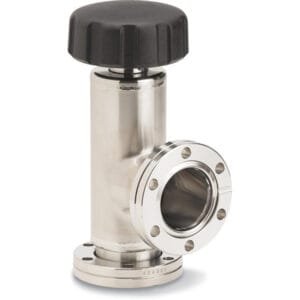45° KF (QF) HV Radius Elbows
45° KF (QF) HV Radius Elbows are precision-engineered components used in high-vacuum (HV) and ultra-high-vacuum (UHV) systems. These elbows are designed to provide a smooth, controlled 45-degree directional change in vacuum lines, maintaining optimal gas flow and reducing the risk of turbulence, pressure loss, and contamination in vacuum systems.
Key Features
Material: Made from high-quality stainless steel (304L or 316L), ensuring durability, excellent resistance to corrosion, and minimal outgassing for enhanced vacuum performance.
45° Bend Design: The 45-degree bend allows for more flexible vacuum system configurations, ideal for systems with limited space while still requiring efficient gas flow.
KF (QF) Flange Connection: Compatible with ISO-KF (QF) fittings, providing fast, secure, and leak-tight connections without the need for welding or special tools.
Leak-Tight Performance: Precision machining ensures tight, reliable seals to prevent leaks in high-vacuum and UHV environments.
High-Performance: Helps maintain smooth gas flow with minimal pressure drop and turbulence, enhancing the performance of the vacuum system.
Applications
Semiconductor Industry: Used in vacuum systems for processes such as thin film deposition, plasma etching, and ion implantation, where maintaining precise vacuum conditions is crucial.
Research & Development: Ideal for scientific laboratories using vacuum chambers for various types of research, including electron microscopy, spectroscopy, and high-energy physics experiments.
Vacuum Coating and Sputtering: Essential in industries that require precise vacuum environments for thin-film deposition in the production of electronics, optics, and solar panels.
Industrial Vacuum Systems: Suitable for aerospace, chemical, pharmaceutical, and other industries where high-vacuum systems are vital for manufacturing and research processes.
Why Choose TFM’s 45° KF (QF) HV Radius Elbows?
Enhanced Flexibility: The 45° angle allows for better system flexibility in tight spaces without sacrificing performance.
Leak-Free Operation: Ensures leak-tight, reliable seals for high-vacuum applications.
Durable and Corrosion-Resistant: Constructed from high-quality stainless steel to withstand demanding environments and ensure long-lasting performance.
Minimized Gas Flow Disruptions: Designed to reduce turbulence and pressure drop, ensuring smooth and efficient vacuum system operation.
Customizable Sizes: Available in various diameters and configurations to meet specific vacuum system requirements.





Reviews
There are no reviews yet.